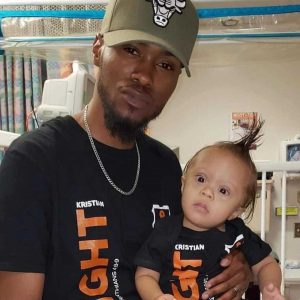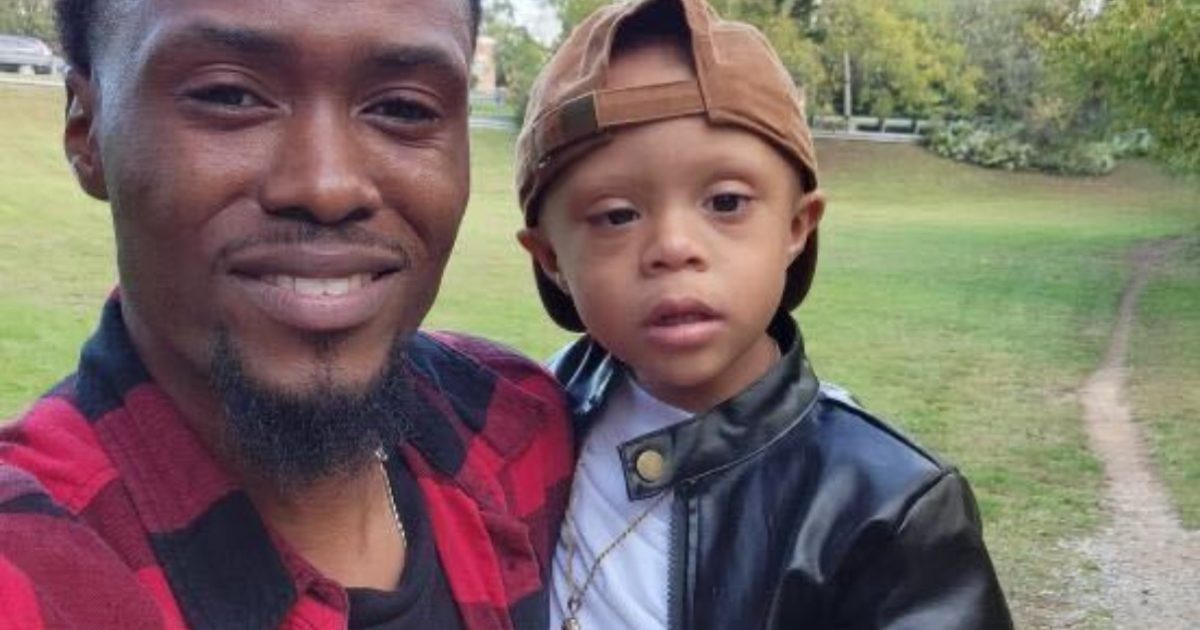Dancing Away Acute Myeloid Leukemia
- Kristian was just 14 months old in June 2018 when he was diagnosed with acute megakaryocytic leukemia (AKML). Thankfully, he beat the disease in November 2018.
- A video of Kristian and his father, Kennith Allen Thomas, celebrating Kristian’s cancer-free status after he beat the disease by dancing together went viral.
- Acute myeloid leukemia (AML), is a blood cancer that affects the spongy tissue inside of your bones called bone marrow. Acute megakaryocytic leukemia (AKML) is a rare subtype of AML more commonly found in children with Down syndrome, which Kristian has.
Kristian was just 14 months old in June 2018 when he was diagnosed with acute megakaryocytic leukemia (AKML) a rare subtype of acute myeloid leukemia more commonly found in children with Down syndrome, which Kristian has. Following his diagnosis, he immediately started chemotherapy.
Read MoreView this post on Instagram
In a viral video with the words “when your son is cancer free” written at the top, Kennith can be seen busting a move with little Kristian wearing a matching outfit in his arms. Eventually, the nicknamed “dancing dad” even lets his son down to dance alongside him. Their energy is infectious and their faces are full of pure joy.
“You never really know when’s the last day that you’re here on Earth,” Kennith told SurvivorNet. “Why continue to spread negativity, when you can spread so much love even in a trying time and in a place where there can be so much more discouragement going on because something tragic has happened to you… You can also have the choice to flip that and turn that negative into a positive and take things to another level and change your entire outlook on life.”

And Kennith has continued to spread love by posting more videos of him and his son dancing. But the cancer-free video, in particular, is much more than just a dance video for Kennith.
“We’re bringing awareness to not only cancer but also Down syndrome, and it's making the world, I believe, a better place… planting a small seed to allow people to see a father and son celebrating together,” he said. “There’s so many different aspects of it, but I believe that truly it’s really to inspire people, and it’s giving them hope, giving them joy for those that are going through the same situation. It gives them a sense of encouragement that we made it through, and so can you. We do these dances every single month because I just truly believe in celebrating every day that you’re alive.”
View this post on Instagram
And not only do Kennith and his son celebrate being cancer free, but they also celebrate Kristian’s quick path to recovery. After doctors told his family it would take anywhere from 300 days to possibly up to two years for him to hopefully defeat his cancer, Kristian did it in just 149. He beat the disease in November 2018, and Kennith credits their positive outlook and continued faith for his son’s success.
“I oftentimes say when we change the mind, we change the game,” he said. “And when we do that, you know, so many different things can change. And for us, it was our son defeating cancer in half the time.”
Understanding Acute Myeloid Leukemia
Kristian’s type of leukemia, acute megakaryocytic leukemia (AKML), is subtype of acute myeloid leukemia (AML) a blood cancer that affects the spongy tissue inside of your bones called bone marrow. The AKML subtype is a rare one that most commonly affects children who have Down syndrome. Acute myeloid leukemia, in general, is also a rare cancer, but it is the most common type of leukemia in adults.
Dr. Mikkael Sekeres breaks down acute myeloid leukemia
Dr. Mikkael Sekeres, chief of the Division of Hematology at the University of Miami Sylvester Comprehensive Cancer Center, explains that bone marrow is essentially the factory that makes all of the cells in the blood stream. This includes the red blood cells that bring oxygen to our tissues, white blood cells that make up the immune system and the platelets which help stop bleeding.
When a person has AML, "that factory gets broken" because the bone marrow fills with cancer cells. Ultimately, this hinders the creation and function of the important blood cells.
"So there's a bit of a paradox," Dr. Sekeres previously told SurvivorNet. "The bone marrow has too many cells, yet the bloodstream has too few cells as the normal bone marrow cells die off."
Symptoms of AML can include shortness of breath, decreased exercise tolerance, unexplained bruising or infections. But sometimes people with AML have no symptoms at all.
Dr. Gail Roboz explains the symptoms of AML
"Most of the time, this comes as an unwelcome surprise diagnosis," Dr. Gail Roboz, a medical oncologist at Weill Cornell Medicine, previously told SurvivorNet. "Often, patients have no idea that leukemia is even anywhere on the radar."
Childhood Cancer
Unfortunately, Kennith Allen Thomas is not alone in having to watch his child battle cancer.
“The video going viral, it means to me that there are many people that are understanding, you know, what it is that we went through,” Kennith told SurvivorNet.
Treatment advances in recent decades have lead to 84 percent of children with cancer now surviving five years or more, according to the American Cancer Society. This is up from 58 percent from the mid-1970s.
But according to the National Pediatric Cancer Foundation, more than 95 percent of childhood cancer survivors have significant health-related issues because of the current treatment options, and only 4 percent of the billions of dollars spent each year on cancer research and treatments are directed towards treating childhood cancer in the United States. Since 1980, fewer than 10 drugs have been developed for use in children with cancer while hundreds of drugs have been created exclusively for adults.
Dr. Elizabeth Raetz, director of pediatric hematology and oncology at NYU Langone's Perlmutter Cancer Center, reminded us in a previous interview that there is still reason for hope.
"There are also targeted treatments and different immunotherapies that have been studied in adults and have now moved into clinical trials for children and there has been a great deal of excitement in the community about that," Dr. Elizabeth Raetz told SurvivorNet.
Still, navigating a child's cancer diagnosis can be tricky.
Jayne Wexler’s son battled acute lymphoblastic leukemia and now deals with heart disease as a side effect of chemotherapy. In a previous interview with SurvivorNet, Wexler explained that in addition to regular parent worries having a child with cancer means living with a whole new world of anxieties.
The Impact of a Childhood Cancer Diagnosis on the Whole Family Jayne Wexler Shares Her Story
"My husband and I will always have fear," she said. "I don't think we can ever let go of that. Just when he was OK, then he relapsed, and then he had the bone marrow transplant … so there's always some sort of worry."
Wexler admits she tries to live for each and every day, but its understandable that this does not always come easy.
"And I do try you hear people say this we do have to live each day and be thankful for what we have," Wexler said. "And it's hard to remember that when you're caught up … it's very hard to just sort of enjoy the moment, because we just don't know what's going to happen in the future."
Learn more about SurvivorNet's rigorous medical review process.


